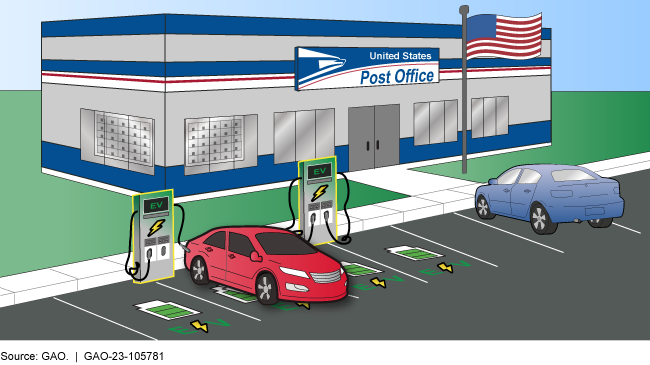Electric Vehicle Infrastructure: USPS Should Plan for Potential Workplace Charging
Fast Facts
The U.S. Postal Service (USPS) is preparing to introduce electric vehicles into its delivery fleet, and is planning to install chargers for these fleet vehicles at some facilities. USPS employees could also benefit from these chargers by being able to charge their personal vehicles during a work shift.
However, USPS has not incorporated the potential for sharing its fleet chargers with employees—or installing additional chargers for employee use—into its facility preparation plans.
We recommended USPS do so to help ensure that its plans are taking into account the potential future needs of its employees.

Highlights
What GAO Found
The United States Postal Service's (USPS) facilities, such as post offices, could potentially provide the public and postal employees with electric vehicle chargers. For example, publicly-accessible chargers could serve community members without a charger at their home. Additionally, five of the 13 stakeholders GAO interviewed said employees would most benefit from chargers at USPS facilities, given the time available to charge a personal vehicle during a work shift.
However, hosting chargers for the general public would pose significant challenges and provide relatively few benefits to USPS, according to USPS officials and stakeholders whom GAO interviewed. For example, USPS officials said hosting public chargers could be at odds with USPS's goal of moving customers in and out of a facility quickly. Moreover, USPS is generally prohibited from offering nonpostal services, and officials said addressing challenges could require significant resources. In light of these and other challenges, USPS has not pursued chargers for the general public. Stakeholders GAO interviewed also recognized these challenges, but a few noted potential benefits for USPS, including improving USPS's reputation on environmental issues and enhancing its relevance.
USPS is preparing to introduce electric vehicles into its delivery fleet and is planning to install chargers for these fleet vehicles. However, USPS has not fully incorporated the potential for employee workplace charging into these plans. USPS has taken some initial steps to explore the potential for employees to charge their own vehicles at work. These steps include designating leadership and surveying some employees on their interest. USPS officials said there are complex issues USPS would need to resolve before it could establish a workplace charging program, such as developing policies and potentially negotiating work rules with multiple employee organizations. However, the facility assessments USPS has developed in planning to install fleet chargers have not examined the potential for sharing fleet chargers with employees, or for installing additional chargers for employees' use. Department of Energy (DOE) guidance encourages agencies to plan for long-term needs when installing chargers. Incorporating the potential need for workplace charging into current planning activities could spare USPS the expense of modifying facilities in the future.
Illustration of a Hypothetical USPS Facility Prepared for Electric Vehicle Chargers to Serve Postal Delivery Vehicles and Potential Additional Users in the Future

Why GAO Did This Study
The federal government is poised to invest billions of dollars in public chargers. Given the number and location of USPS facilities, some stakeholders and policymakers have suggested that public chargers at postal facilities could help advance federal efforts.
GAO was asked to determine the feasibility of using USPS facilities to host public chargers. This report, among other things, (1) describes the groups that might use these chargers, (2) describes the potential benefits and challenges to USPS of hosting chargers, and (3) examines the extent to which USPS has considered options for workplace charging at its facilities as it moves to electrify some of its delivery fleet.
GAO conducted a literature review, reviewed charger site-selection guides, and analyzed USPS facility data. GAO also interviewed USPS officials as well as 13 federal and private-sector stakeholders, including DOE and industry associations, selected based on factors such as their engagement in electric vehicle charging issues. GAO compared USPS's actions to consider workplace charging with applicable guidance, such as from DOE.
Recommendations
GAO recommends that the Postmaster General ensure appropriate USPS leaders incorporate the potential for workplace charging into planning efforts to deploy fleet-charging infrastructure. USPS partially agreed. GAO believes considering the potential for such charging would be beneficial.
Recommendations for Executive Action
| Agency Affected | Recommendation | Status |
|---|---|---|
| United States Postal Service | The Postmaster General should ensure that the leadership of the Next Generation Delivery Vehicle Program and the sustainability office incorporate the potential for workplace charging in USPS's site planning efforts to deploy fleet-charging infrastructure. (Recommendation 1) |
As of March 2024, USPS officials stated that the agency had procured charging station hardware that allows for employee charging capabilities in the future. GAO is evaluating USPS's efforts.
|
